“Go to the ant, thou sluggard; consider her ways, . . .”
Proverbs 6:6
I have. And for some reason they’ve been on my mind quite a lot recently. Not sure why. I’ve got a suspicion that it has something to do with the fact that lately I’ve been experiencing one of my periodic bouts of homesick-longing for a dose of tropical rainforest – the most diverse, species-rich terrestrial ecosystem on earth. And, of course, one cannot visit there without encountering ants. As a biologist, when I think of ants, I tend not to ponder them as bothersome pests intent upon ruining our picnic. Instead I see them as imminently fascinating, complex social insects, and one of the most biologically successful groups of animals on the face of the planet.
Let me first explain what I mean by biological success. Success in this sense means something quite different than the manner in which the term is used in everyday parlance. After all, ants don’t seek wealth, political power, or social status. These seem to be common standards for measuring success among us humans. No, when I speak of biological success, I am using an entirely different set of criteria. For example, one way we measure biological success is by the number of species which have evolved within a particular group over time. Among the ant fraternity, there are over ten thousand species known with more yet to be discovered most likely. For purposes of comparison, there are only two species of pandas in the world. So, by this standard, we would have to say they are less biologically successful than ants. I suppose some might argue that dinosaurs would be the best example of an unsuccessful group. After all, they are extinct. But then we would have to decide how we were going to deliberate the fact that they were the dominant form of vertebrate life on earth for over one hundred million years. And, of course, there is the intriguing issue of the modern-day existence of some of them in the form of birds to be considered as well. Alas, all this would but complicate our consideration of biological success. Perhaps another time.
A second measure of biological success is the number of individuals within a particular group. By this criterion pandas would again be considered less successful than ants. There are some one thousand giant pandas and ten thousand red pandas remaining in the wild. Ants, on the other hand, have world-wide numbers estimated to be as high as fifteen quadrillion individuals (a one followed by fifteen zeros).
How long a group of organisms has been around (geologic distribution) is another measure of biological success. Ants show up in the fossil record around one hundred million years ago, a thousand times longer than modern man has been here. So, score one more for the ants.
And then there is geographical distribution to consider. How many different places on earth are home to the group in question? Because of our ability to manipulate environments, humans are wildly biologically successful by this measure. But the ants don’t do badly by this benchmark. Ants of one sort or another occur naturally everywhere on earth except for the planet’s very coldest regions. Thus, by all standards, they are exceedingly successful animals. This is especially true in the tropics.
And this brings me back to my recollections regarding tropical rainforests and ants. The biological success of the pismire clan is a phenomenon to consider, but even more captivating are the unbelievably complex behaviors and ecological relationships which have evolved among tropical ants. In regards to further contemplations of fascinating behaviors and social organization among tropical ants, there are so many nominees that it is difficult for me to choose any one. Army ants come to mind immediately. My first recollection of learning about army ants was via the 1954 movie The Naked Jungle starring Charlton Heston. As an impressionable eight year-old, I was terribly captivated by an ant army that could lay waste to an entire  rainforest as though a phalanx of bulldozers had passed over. Equally shocking was their ability to quickly devour an inattentive human like so much spilled sugar. Many years later, I was to gain a more realistic knowledge of army ant behavior but nevertheless still find them fascinating.
rainforest as though a phalanx of bulldozers had passed over. Equally shocking was their ability to quickly devour an inattentive human like so much spilled sugar. Many years later, I was to gain a more realistic knowledge of army ant behavior but nevertheless still find them fascinating.
There is a wealth of fascinating behavior to be considered when army ants are the subject. But there is another ant in the Neotropics which, in many ways, fascinated me even more upon my first encounter.
May I introduce Paraponeura clavata, the bullet ant, also known as the conga or giant hunting ant. The first time I saw one of these clambering up the trunk of a nearby tree I was stunned by its size. Back in Indiana the largest ant I usually ran into was the carpenter ant. A big one might approach a half inch in total length. The bullet ant I saw busily foraging on the tree bark was 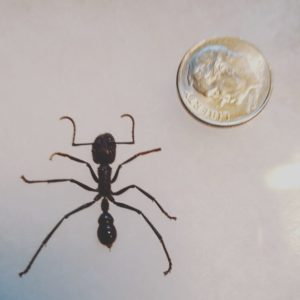 three times that size. Coal black with a wicked looking set of stout mandibles, it was the first ant I had ever encountered that fairly screamed – don’t touch me! Paraponeura also packs a mighty wallop in the form of a venom injecting stinger at the tip of its abdomen. The intense pain of this wound persists for many hours. It is a pain said to be comparable to being shot, thus the name bullet ant. An entomologist by the name of Justin Schmidt has actually developed a scale for ranking the pain caused by the stings of various hymenopterans (ants, bee, and wasps). One must admire both his dedication to science and gallantry in developing his index of pain. Admittedly the degree to which pain is felt is somewhat subjective and, for those allergic to insect stings, any encounter can be life threatening. But be this as it may, Schmidt ranks the bullet ant numero uno when it comes to discomfort. On his pain scale of 1-4, it is a 4+. Schmidt described the sting of a single bullet ant as pain which was “pure, intense, brilliant, agonizing, and long lasting”. He reckoned the intensity of the sting to be several dozen times that of a common paper wasp.
three times that size. Coal black with a wicked looking set of stout mandibles, it was the first ant I had ever encountered that fairly screamed – don’t touch me! Paraponeura also packs a mighty wallop in the form of a venom injecting stinger at the tip of its abdomen. The intense pain of this wound persists for many hours. It is a pain said to be comparable to being shot, thus the name bullet ant. An entomologist by the name of Justin Schmidt has actually developed a scale for ranking the pain caused by the stings of various hymenopterans (ants, bee, and wasps). One must admire both his dedication to science and gallantry in developing his index of pain. Admittedly the degree to which pain is felt is somewhat subjective and, for those allergic to insect stings, any encounter can be life threatening. But be this as it may, Schmidt ranks the bullet ant numero uno when it comes to discomfort. On his pain scale of 1-4, it is a 4+. Schmidt described the sting of a single bullet ant as pain which was “pure, intense, brilliant, agonizing, and long lasting”. He reckoned the intensity of the sting to be several dozen times that of a common paper wasp.
In his book Tropical Nature: Life and Death in the Rain Forests of Central and South America, biologist Adrian Forsyth described an encounter with a bullet ant while in Ecuador. The ant dropped down the collar of his shirt and rapidly delivered four powerful stings in his neck and shoulder. He described the result as feeling “as if a red hot spike had been driven in. After an hour of burning, blinding pain,” Forsyth reported that he was left with “a sore back and lymph nodes in my armpit that were so swollen that I could not move my arm without pain for the next two days.” Yes indeed, the bullet ant is quite an intimidating fellow.
On my first visit to Peru, I avoided any run-ins with this intimidating creature. The same was true for my next three trips to the Peruvian Amazon. On my fifth trip, my luck ran out. It was a night walk upon the ACTS canopy walkway that led to my encounter. As a matter of habit, I always watch where I am putting my hands when in the rainforest. Aside from bullet ants, there are thorny plants, scorpions, wandering spiders, and eyelash vipers that need avoiding. Upon the walkway at night, while trying to traverse the swaying, bouncing, walk-boards maintaining one’s balance becomes a significant challenge. On my most recent trip (2019), I found myself suddenly totally off balance and swaying to one side. Reflexively grabbing a supporting walkway cable, I abruptly felt Schmidt’s “pure, intense” pain. I had inadvertently placed my hand upon a foraging bullet ant. An hour or so later I had returned to the lodge. By then my hand had begun to swell and the pain had migrated from the afflicted finger into the rest of my hand. Gradually the pain began to spread up my arm eventually reaching to my elbow and then upper arm. For over four hours I gritted my teeth as a pain that felt like red wasp X10 throbbed within my left hand and arm. As I write, some three months later, I can still look upon my left, middle finger and see the evidence of the attack. On the underside of my finger tip are the two telltale marks made by the ant’s mandibles as it seized hold. These are adjoined by the mark left by the stinger which the ant had so quickly and deftly inserted. Rest assured; this is a rainforest experience that will remain with me always.
Although I cannot speak from direct observation, I have heard tell of a most unusual human-bullet ant interaction. There exists a tribe in the Brazilian Amazon known as the Sateré-Mawé. The status of warrior is highly valued among these people. As in other similar cultures, young men must endure an initiation ritual to achieve this esteemed standing and here is where the bullet ant enters the picture Hundreds of Paraponeura are collected for the ceremony (there are multiple videos of this rite at youtube.com). Using a naturally occurring botanical sedative, the ants are drugged into a comatose state. The now placid bullet ants are then inserted, stinger first, into a pair 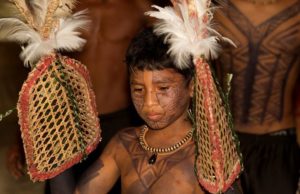
of gloves made of woven plant fibers. One observer has compared them to large oven mitts. The young male initiate then has these extraordinarily uncomfortable mittens placed over his hands. Of course by now the bullet ants have awakened from their lethargic state and are very much displeased to find themselves entrapped in the gloves. They express this discontent by delivering dozens upon dozens of stings to the hands of the aspiring warrior. One might imagine that enduring this torment for a matter of seconds would be quite sufficient. But this is not so. The inductee is expected to withstand the agony of the bullet ant stings for ten minutes and must do so without screaming in anguished pain. Oh, there is another requirement for this ceremony. The young warrior candidate must, over a period of time, repeat this rite an additional nineteen times (https://en.wikipedia.org/wiki/Mawé_people). Having endured the sting of this ant once, I cannot imagine the agony these young initiates must bear.
All these things considered, I would rank the bullet ant as one of the most fascinating of the tropical rainforest ants. But remember, should you have the opportunity to travel to the Neotropics yourself, be exceedingly careful where you place your hands. And if you find yourself in Sateré-Mawé country I would think twice about an invitation to join their warrior clan.
There are even more ant candidates of interest, but if I must choose one group of ants to share with you this time, it would have to be the leafcutter ants. In fact, if asked to choose a non-human animal with the most complex social organization on earth, I would be hard pressed to find a better example than the leafcutter ants. They are even more astounding when we also consider the nearly unfathomable intricacy of the mutualistic relationship they have formed with another organism in their environment – a type of fungus.
To begin, we must remember that leafcutter ants are social insects. Such 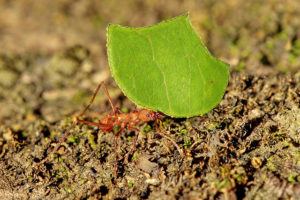 insects (most bees, wasps, other ants, and termites too) live in colonies. Within these colonies, the jobs of scouting for and collecting food, defending against enemies, nest building, reproduction, and myriad other tasks are divided among members of the colony specialized for each role. Typically, a particular body anatomy is associated with such specialization. This allows the job to be done with utmost efficiency. Such division of labor bears an uncanny resemblance to the manner in which the jobs within human society are divvied up. The specialized body forms/occupations within a colony of social insects are referred to as castes.
insects (most bees, wasps, other ants, and termites too) live in colonies. Within these colonies, the jobs of scouting for and collecting food, defending against enemies, nest building, reproduction, and myriad other tasks are divided among members of the colony specialized for each role. Typically, a particular body anatomy is associated with such specialization. This allows the job to be done with utmost efficiency. Such division of labor bears an uncanny resemblance to the manner in which the jobs within human society are divvied up. The specialized body forms/occupations within a colony of social insects are referred to as castes.
Among leafcutter ants, the evolution of castes has been taken to extremes with as many as six different ones being recognized. The largest caste  member is the lone queen who measures about 20 mm in length. Her primary job is to lay the eggs from which all other colony members are derived. Males form another caste but they are short-lived and their only function is to mate with the queen. Shortly after doing so they die, so most colonies are absent of males for long stretches of time. The remaining members of the leafcutter ant colony belong to the worker caste of sterile females which may number four or five million. The leafcutter worker caste is further subdivided based upon size into minims, minors, media, and majors. Each of these performs some specific job or jobs within the colony. Minims (2 mm) work inside the nest, tending larvae for example. These nests, by the way, can be huge. I once saw a leafcutter nest (they look something like an expanse of tilled soil) in the Manu region of
member is the lone queen who measures about 20 mm in length. Her primary job is to lay the eggs from which all other colony members are derived. Males form another caste but they are short-lived and their only function is to mate with the queen. Shortly after doing so they die, so most colonies are absent of males for long stretches of time. The remaining members of the leafcutter ant colony belong to the worker caste of sterile females which may number four or five million. The leafcutter worker caste is further subdivided based upon size into minims, minors, media, and majors. Each of these performs some specific job or jobs within the colony. Minims (2 mm) work inside the nest, tending larvae for example. These nests, by the way, can be huge. I once saw a leafcutter nest (they look something like an expanse of tilled soil) in the Manu region of 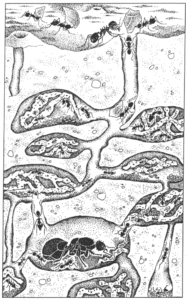 Peru which was forty feet in diameter. Such a nest can go downward into the ground thirty or forty feet and may contain hundreds of interconnected subterranean chambers. Minors protect their foraging sisters and help defend the nest from enemies. Members of the media caste (10 mm) locate food, cut leaves, and transport them back to the nest. The major caste members are large (15-20 mm) with massive heads which house powerful muscles for operating their huge mandibles. These ants are often simply referred to as soldiers and their primary job is defending the colony against attack.
Peru which was forty feet in diameter. Such a nest can go downward into the ground thirty or forty feet and may contain hundreds of interconnected subterranean chambers. Minors protect their foraging sisters and help defend the nest from enemies. Members of the media caste (10 mm) locate food, cut leaves, and transport them back to the nest. The major caste members are large (15-20 mm) with massive heads which house powerful muscles for operating their huge mandibles. These ants are often simply referred to as soldiers and their primary job is defending the colony against attack.
This extreme division of labor is wonderfully interesting in its own right, but now on to some of the even more amazing details in the life of a leafcutter ant society. To begin with, leafcutters do not indiscriminately harvest leaves from just any species of plant. They are selective and may travel far from their nest to obtain the leaves of a particular kind of plant. In one study, only about thirty-one percent of the available plants were utilized by the ants. The underlying reason for this is connected with the most remarkable aspect of leafcutter behavior. They avoid certain plants not because of the danger they might pose should the ants eat the leaves themselves. In fact, the leaves they harvest are not for their own consumption. Instead the leaves are gathered to serve as fodder for the special fungus that the ants grow within their subterranean nests. It is this fungus that is their primary food. We might well consider leafcutter ants to be earth’s first farmers!
Plants have, over time, evolved chemical defenses against the animals which try to eat them. The variety of defensive chemicals produced is impressive and includes cardiac and cyanogenic glycosides, calcium oxalate, caffeine, nicotine, and terpenoids. Some of these chemicals cause a bad taste, some burn the mouth, others may cause nausea, and certain others may attack an animal’s nervous or cardiovascular system. Unsurprisingly, some plants produce chemicals which are toxic to the fungus that is grown by the ants (the aforementioned terpenoids for example). Such plants are identified and studiously avoided by the ants lest they bring back toxic leaves which would decimate their primary food source – the fungus garden.
The variety of defensive chemicals produced is impressive and includes cardiac and cyanogenic glycosides, calcium oxalate, caffeine, nicotine, and terpenoids. Some of these chemicals cause a bad taste, some burn the mouth, others may cause nausea, and certain others may attack an animal’s nervous or cardiovascular system. Unsurprisingly, some plants produce chemicals which are toxic to the fungus that is grown by the ants (the aforementioned terpenoids for example). Such plants are identified and studiously avoided by the ants lest they bring back toxic leaves which would decimate their primary food source – the fungus garden.
As noted, the medias search for and locate leaves, cut small circular pieces from them, and transport these pieces back to the nest. When standing, looking down upon a column of foraging leafcutter ants I have been reminded of the view of an automobile freeway from a traffic helicopter. Thousands of determined travelers are seen marching back to the nest with their treasured piece of leaf, stem, or flower petal. In the opposite lanes, empty-jawed workers trek steadfastly away from the nest on their return trip to the leaf source. The leaves they seek may be located in a tall forest tree and involve a considerable climb to reach. Ascending into a one hundred feet tall tree, a worker would be climbing to a height over three thousand times its own body length. This is the equivalent of a six feet tall human climbing a mountain over three miles high to reach a food source. If this human weighed one hundred and eighty pounds they would then, to match the feat of strength of a leafcutter worker, have to carry back down a weight of around one and a half tons. And this climbing, descending, and carrying would have to be done repetitively. The amount of leaf material collected by a colony is impressive as well. A study quoted in John Kricher’s excellent introduction to tropical Central and South America – A Neotropical Companion – found that leafcutter ants consume three-tenths of a ton of foliage per hectare each year. Thus, for example, in an area the size of La Selva Biological Station in Costa Rica (3900 acres) we would expect these ants to consume 468 tons of vegetation per year. Kricher notes that such herbivorous feeding is equivalent to the combined efforts of all the vertebrates in a particular area of forest.
The foraging leafcutter ants make very distinct, cleared trails over which 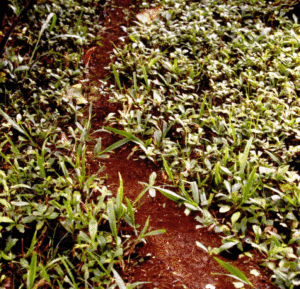 they transport their leaf bits. Media workers build and maintain these trails. Their paths remind me of little, miniature versions of well-trodden human footpaths. As media workers age, they are assigned the garbage detail and work to remove dead ant bodies, bits of dead fungus, and decomposing leaf bits. These waste materials are hazardous to the colony and are dumped outside the nest, above ground in a waste midden.
they transport their leaf bits. Media workers build and maintain these trails. Their paths remind me of little, miniature versions of well-trodden human footpaths. As media workers age, they are assigned the garbage detail and work to remove dead ant bodies, bits of dead fungus, and decomposing leaf bits. These waste materials are hazardous to the colony and are dumped outside the nest, above ground in a waste midden.
Minor workers perform one of the most mind-bendingly, fascinating jobs in the entire colony. Leafcutter ants, like all animals, have their enemies. One of the most crafty is a type of fly called a phorid. These flies parasitize leafcutter ants. A favorite ploy of the phorids is to attack a worker who is busy transporting a bit of leaf. Thus employed, the worker is unable to mount an effective defense against the fly. The phorid swoops down and lays an egg on the leafcutter worker’s head. As you may guess, the egg then hatches into a larva that proceeds to burrow into the ant and begin feeding resulting in the ant’s death. To prevent this ghastly chain of events, minors often ride on the body of a foraging worker or on the leaf which it is carrying. By riding shotgun, they can fend off the attack of a phorid fly intent on parasitizing the hapless worker. (Note the smaller ants riding on the leaf pieces in the photo below.)
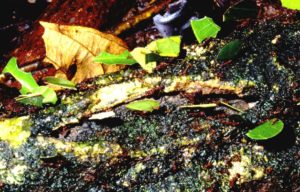
Back at the nest, pieces of leaf material are handed off to the smaller minim workers and here begins a chain of events of extraordinary behavioral and biochemical complexity. The surfaces of the leaf particles are first cleaned by the minims to remove any bacteria that might infiltrate and attack the fungus garden. Minims then proceed to chew the leaves into a macerated pulp onto which they introduce the fungus which will constitute their garden. Studies have shown that this fungus will not grow properly without the presence of the ants. Grown on a protein medium alone, the fungus will not survive. Researcher Michael Martin studied the biochemistry of the ant-fungus relationship and found that the ants, as they prepare the leaf bits, release a tiny drop of their own rectal fluid onto the pieces. This fluid, he found, contains a mixture of organic compounds including all the amino acids needed for synthesizing proteins. Since the fungus is unable to break down large protein molecules itself, it relies on the amino acids in the ant rectal fluid to be able to build the protein molecules used for constructing its own mycelial body.
found, contains a mixture of organic compounds including all the amino acids needed for synthesizing proteins. Since the fungus is unable to break down large protein molecules itself, it relies on the amino acids in the ant rectal fluid to be able to build the protein molecules used for constructing its own mycelial body.
There is one final twist, a most coherent end-game, to all this. We might ask why the ants don’t just eat the leaves and bypass the laborious, complicated process of maintaining their fungus garden. The final, ultimate benefit they receive from pursuing this arduous relationship is as follows. Cellulose is a primary structural component of plants, it is one of the most abundant organic compounds in nature (there are lots of plants in the rainforest!). Cellulose is a polysaccharide i.e. a starch. Starches are composed of long chains of glucose molecules. Glucose is analogous to the gasoline for our automobiles; it is the basic cellular fuel for most living things. The ants need this fuel but they do not produce the cellulose digesting enzyme required, i.e. they cannot digest the leaves. Their fungal symbionts do produce cellulase enzymes. The fungus in the ant’s garden digests the cellulose in the leaves into sugars. These sugars are then assimilated into the corpus of the fungus. Thus by eating the fungus, the leafcutter ants ultimately access much of the glucose energy stored in the many tons of leaves they harvest in a year’s time – the whole point of this unbelievably complex chain of behavioral and biochemical events.
Thus there is total interdependence between the leafcutter ants and the fungus in regards to the survival of each. This is why their relationship is referred to as mutualism – a type of symbiosis beneficial to both organisms. And, in this case, the symbiosis is not only mutually astounding ecological relationship beneficial but obligatory. They cannot survive without one another.
I hope your mind has been suitably boggled by the bizarre world of the leafcutter ant. It is certainly so with mine.
And now finally, we must consider this.
The only person to see a new species of orchid may be the bulldozer operator who is clearing the only two or three acres of rainforest land in the world where this species occurs.
Anon.
The small, hilltop patch of irregular canopy (right center) is rainforest. Much of it has been displaced by the regular rows of oil palm plantation. The more uniform tree canopy profile is composed of rubber tree plantation.
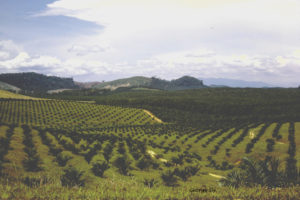
Biologists believe that the leafcutter ant/fungus association is at least fifty million years old. Can you comprehend that span of time? Admittedly, it is difficult to conceive of organisms living cooperatively for a period ten thousand times the length of recorded human history. It is equally difficult to simply grasp that stupendous expanse of deep time. Can you envision the intricate goings on within the leafcutter colony – the pheromonal exchange of information between queen and caste members, the complex division of labor within the worker caste, the intricate interplay of enzymes, amino acids, and proteins which drive the survival of ant and fungus? What a wondrous natural phenomenon we experience when we consider the leafcutter ant.
How many other wonders of equally astounding complexity exist in the tropical rainforests of the world? No other terrestrial ecosystem exists which equals the diversity of species found here. Even now, in the 21st Century, the tropical rainforests have been incompletely studied. And yet some twenty million acres of tropical rainforest (thirty-one thousand square miles) are destroyed by humans each year. This is a land area equivalent in size to the state of South Carolina. I find it difficult to comprehend how much life must exist in 31,000 mi2 of tropical rainforest.
I read such statistics with dismay(rainforests.mongabay.com/facts/rainforest-facts.html). I think of the sophisticated tapestry that is leafcutter ant society and wonder, what other marvels of the natural world are we losing? How many species of organisms have disappeared without our ever having been aware of them? What intricacies of behavior, biochemistry, and symbiosis have been lost while humanity remains blissfully ignorant? Many of our medicines are derived from the complex defensive chemicals produced by plants. What potential sources of antibiotics, analgesics, and anesthetics have been lost while we remain unaware that they even existed? By what ethical imperative do we justify the destruction of an ecosystem which represents the crown jewel of the Creation? What imperious conceit would allow us to extinguish, with barely a second thought, a biological interdependence fifty thousand millennia in the making? Will my great-great-grandchildren also be able one day to walk within a tropical rainforest? Will they have the chance to experience for themselves the bullet ant’s frightening demeanor? Will they be given, as I have, the opportunity to gaze in rapt wonderment upon the extraordinary march of the leafcutter ants?
**********************************
Photo credits:
Fungus colony – Alex Wild @ Wikimedia Commons
Leafcutter Ant – Wikimedia Commons
Leafcutter Ant nest illustration – Erich Hoyt 1996
Leafcutter Ant castes – Wikimedia Commons
Satere’-Mawe’ initiation – Bruno Kelly at psu.edu
All others by the author.
